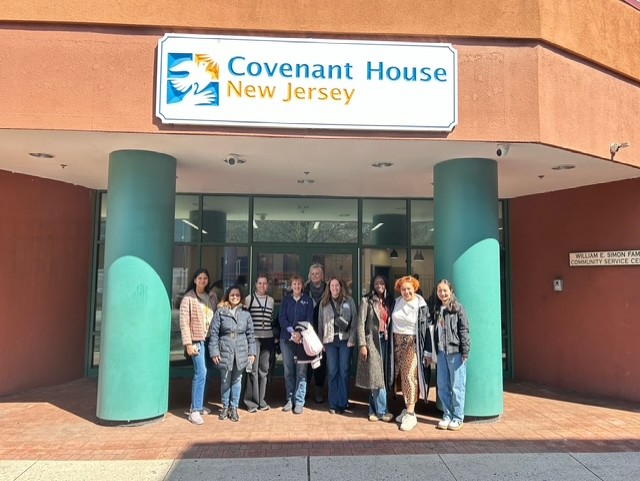On May 8, 2023, researchers from Covenant House New Jersey and Harvard Medical School and HEAL Trafficking publicly released a new article published in Criminal Law Bulletin, “A Case of Mistaken Identity: The Criminalization of Victims of Labor Trafficking by Forced Criminality.”
Executive Summary
Human trafficking survivors are victims of a crime. Labor trafficking by forced criminality (LTFC) survivors are no different. LTFC refers to all labor trafficking where the labor is an illegal activity, such as theft, assault, and drug dealing. Whereas an individual who is sex trafficked is forced, defrauded, or coerced to commit a sexual act, an individual who is labor trafficked by forced criminality is forced, defrauded, or coerced to commit a crime. Covenant House New Jersey’s research has shown that as many as half of all identified human trafficking survivors among youth facing homelessness in NJ have been labor trafficked. Among this group, the most common type of labor trafficking is LTFC.
Aiden was 12 years old when he took a job delivering food products, but later learned he was actually delivering cocaine, methamphetamine, and marijuana. He only received a portion of the money he earned from selling drugs. His trafficker told him that if he didn’t do what he was told or told anybody he would be hurt.
Human trafficking is a notoriously invisible crime because victims are so difficult to find and identify.

Traffickers profit from hiding victims from systems that have the capacity to intervene.
Julia Einbond, study co-author and head of the Covenant House Action and Research Tank (CHART) at Covenant House New Jersey
LTFC victimization tends to be one among a myriad of traumatic experiences, including absent parents and foster care experiences, leaving young people navigating the world with little or no support.
When systems miss tell-tale signs of victimization, victims learn not to trust systems.
Hanni Stoklosa of Harvard Medical School and HEAL Trafficking and one of the co-authors

According to new research published in January 2023, law enforcement in NJ interacted with nearly every LTFC victim who eventually sought shelter at Covenant House New Jersey, but each time they saw only juvenile delinquents and criminals. Yet, the majority of these victims were trafficked long before they were ever arrested. Their first arrests look like children in need of help more than hardened criminals: disorderly conduct, loitering, trespassing, fare evasion, simple assault, possession, and driving offenses. In layman’s terms, these offenses are crimes of poverty, and a signal of the possible presence of childhood trauma. But in all cases, these signals were missed as indicators of LTFC experiences.
But the tragedy of the story doesn’t end there. Once these victims were labeled as criminals, they continued on that path. Over the subsequent years, the victims identified in the research picked up countless more charges, resulting in arrests, fines, and incarceration. Community partner, Elizabeth Ruebman, Policy Director at Newark Community Street Team, agrees, “When systems tell victims that they are criminals, victims are not connected to appropriate victim service interventions that may change the trajectory of their lives.” When the LTFC survivors sought shelter at Covenant House New Jersey and gained access to legal counsel, their pathways changed, resulting in dropped or reduced charges, fines, and fees.
This research makes an urgent public policy argument to think again when a young person is arrested for a low-level crime. When systems miss tell-tale signs of victimization, victims learn not to trust systems. When systems tell victims they are criminals, they establish a pathway to criminalization that may have been avoidable with appropriate victim service interventions.
Key Findings – Labor Trafficking by Forced Criminality
- 83% of LTFC survivors experienced arrest before age 22, and 75% were not arrested for the underlying forced crime.
- 67% of victims experienced unsheltered periods of homelessness. Crimes for which victims were arrested were often related to poverty of homelessness, including criminal trespass, loitering, disorderly conduct, simple assault, fare evasion, and theft.
- 56% of LTFC victims identified as being minors at the time of their trafficking – the youngest was 7 years old at the time of their trafficking.
- Victims had often experienced a number of traumas throughout their life, including more than half of victims having been in foster care at some point.
- Victims appeared to lack caring adult relationships, including 90% having at least one parent who was deceased or absent for a significant part of their childhood.
- 47% of LTFC survivors were identified as having at least one child before age 22. This statistic is significantly higher than rates of parenting youth among those experiencing homelessness and victims of human trafficking in general.
Recommendations – Labor Trafficking by Forced Criminality
- There is a need to increase awareness of LTFC among the public, social service professionals, healthcare providers, and law enforcement. Clients in this study interacted with a number of systems (justice, child welfare, educational) before being identified as a victim, usually years after the victimization occurred. Additionally, the utilization of screening tools in these sectors could provide additional opportunities to identify victims and prevent criminalization.
- Safe Harbor laws have made a difference in conversations around individuals who have experienced sex trafficking. Similar reforms are needed for LTFC victims, whose labor does not align with professionals’ impression of “trafficking.”
- High quality legal representation was impactful for LTFC victims. Increasing access to legal representation for youth experiencing homelessness has the potential to reduce the criminalization of homelessness and poverty and improve outcomes for victims of LTFC.
- This research indicated that LTFC is a pathway into criminalization; with that finding, we need to seek additional avenues out of criminalization. One possible way is access to Victim of Crime Compensation, which was not accessed by any of the LTFC victims.
- This study highlighted a number of areas that need additional research, including the role of trauma in entry into LTFC experiences, temporality of arrest and trafficking experiences in other types of trafficking, and the relationship between LTFC and young parenting.
About Covenant House New Jersey:
For 34 years Covenant House New Jersey has provided shelter, housing, and wraparound services to youth facing homelessness, and since October 2020 has served as the point of entry to victim services for all human trafficking survivors of any age and any housing status throughout NJ. CHNJ created the first validated brief screening tool for human trafficking – Quick Youth Indicators for Trafficking (QYIT) – and has been using QYIT followed by an assessment to identify survivors of human trafficking since 2016.
Authors and Affiliations:
Julia Einbond, JD, Covenant House New Jersey
Kaitlyn Zedalis, MSW, Covenant House New Jersey
Hanni Stoklosa, MD, MPH, Harvard Medical School and HEAL Trafficking














